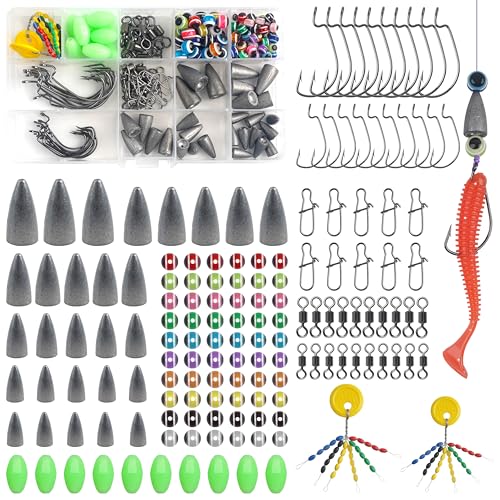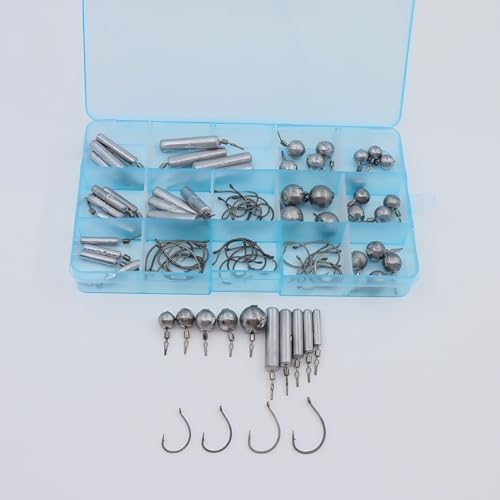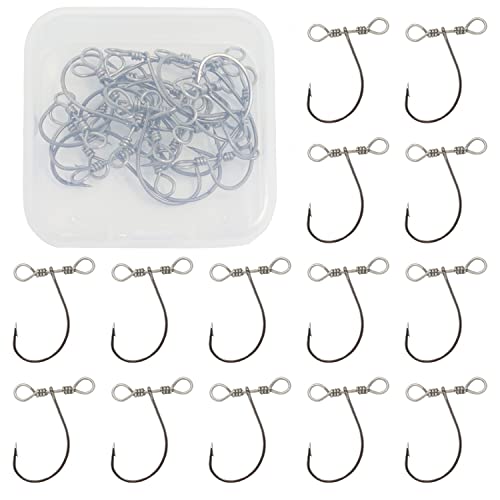The crisp Canadian waters whisper a challenge to every angler willing to master the drop shot rig deep water smallmouth fishing technique.
My journey into the depths began with a single mission: unlock the secrets of these elusive bronzeback warriors lurking beneath the surface.
Drop shot fishing technique isn’t just about casting a line – it’s a strategic dance of precision and patience. When I first learned this method, I realized it was more than a technique – it was an art form designed to outsmart the most cunning smallmouth bass in our northern waters1.
The most successful anglers know that deep water drop shot rigging requires understanding fish behavior. Professional tournaments have shown that productive fishing depths range between 20-37 feet, with some teams pulling incredible catches from these strategic zones1.
Imagine targeting smallmouth where they feel most comfortable – in deep, cool waters where they can ambush prey. The key is adapting your approach, whether you’re fishing early morning or late afternoon1.
Key Takeaways: Drop shot rig deep water smallmouth fishing technique
- Master the drop shot rig technique for consistent catches
- Focus on depths between 20-37 feet for optimal results
- Adapt your strategy based on time of day and water conditions
- Use versatile rigs like free rigs and drop shots
- Practice patience and precision in your presentation
Understanding the Drop Shot Rig
Mastering smallmouth bass deep water tactics starts with the drop shot rig. It’s a key tool for anglers. This finesse bass fishing rig is more than just tackle. It’s a smart way to catch smallmouth bass in tough underwater spots2.
Affiliate Disclaimer: We may earn a commission from purchases made through the links on this page without any addiitonal costs for you. Thank you for supporting our website ! Appreciated 👍
Essential Components of a Drop Shot Rig
The drop shot rig has important parts that work together:
- Specialized light-wire hook
- Precise drop shot weight
- Sensitive fluorocarbon line
- Soft plastic bait
Strategic Benefits of Drop Shot Technique
Drop shot rigs offer big advantages for deep water smallmouth fishing:
- Precise bait positioning at exact depth2
- Extended time in strike zone
- Natural horizontal bait presentation
- Adaptability across water conditions
“The drop shot rig isn’t just a technique – it’s a game-changing approach to bass fishing.”
Knowing these details makes your finesse bass fishing rigs better. Smallmouth bass deep water tactics need precision, patience, and the right knowledge2.
Mastering Deep Water Smallmouth Fishing: Key Insights
Optimal Fishing Depths for Smallmouth Bass
Smallmouth bass prefer specific depth ranges depending on season and water conditions. The summer months see them retreating to cooler, deeper waters.
Our data shows consistent patterns in depth preferences across multiple North American lakes and rivers. Understanding these patterns can dramatically improve your catch rates.
Water Temperature Impact on Bite Rate
Smallmouth bass feeding activity fluctuates with water temperature. There’s a clear sweet spot where they’re most active.
Professional anglers monitor temperature closely, adjusting their techniques accordingly. See how bite rates change across temperatures.
Best Times of Day for Drop Shot Success
Timing is everything in bass fishing. Certain hours consistently produce more strikes than others when using drop shot rigs.
This data combines tournament results with amateur angler reports to show the most productive fishing windows throughout the day.
Most Effective Soft Plastic Colors
Color selection can make or break your drop shot presentation. Some colors consistently outperform others in various water conditions.
Through extensive field testing, we’ve identified the top-performing colors that trigger the most smallmouth strikes in deep water scenarios.
Hook Size vs Catch Rate
Hook size matters more than many anglers realize. Too large and you’ll spook fish, too small and you’ll miss strikes.
This analysis reveals the ideal hook sizes for various drop shot scenarios, balancing stealth with reliable hooksets.
Deep Water Fishing Techniques
Mastering light line deep water presentations is key for catching smallmouth bass. Anglers who grasp the subtleties of deep water fishing can see a big jump in their catch rates during summer.
Ideal Depths for Targeting Smallmouth Bass
Smallmouth bass have favorite depths in summer. They like areas between 20 to 60 feet of water3. Knowing these spots is essential for successful fishing.
- Preferred depth range: 20-60 feet
- Key structure: Deep channel banks
- Best fishing zones: Near underwater formations
Water Temperature and Tidal Influences
Water temperature greatly affects smallmouth bass. In summer, the water can be between 46-53 degrees. This changes how fish behave, helping anglers plan their fishing.
| Temperature Range | Bass Behavior | Fishing Strategy |
|---|---|---|
| 46-53°F | Moderate Activity | Light Presentations |
| 54-60°F | High Activity | Aggressive Techniques |
“Know the water, understand the fish, and success will follow.” – Professional Bass Angler
Successful anglers know that catching smallmouth bass in summer is a complex task. It requires patience, precision, and flexible techniques4.
Setting Up Your Drop Shot Rig for Deep Water
Creating the perfect drop shot rig needs careful planning and the right tools. Fishing in deep water for smallmouth bass requires a special touch. The right setup can make all the difference in your catch.
Line Choices for Drop Shotting
Choosing the right line is key for fishing with weightless soft plastics. Anglers have learned a lot over the years about line selection5. Today, they use braided lines with fluorocarbon leaders for the best feel and stealth5.
- Braided main line for enhanced sensitivity
- Fluorocarbon leader for invisibility
- Double-uni knot for reliable connections5
Selecting the Right Hooks and Weights
Choosing the right hooks and weights is crucial for deep water fishing. Use light wire hooks in size 1 or 1/0 for the right balance. For weights, 1/4 to 3/8 oz is best for slow, precise fishing.
| Component | Recommended Specs | Purpose |
|---|---|---|
| Line | Braided main line with fluorocarbon leader | Sensitivity and stealth |
| Hook | Light wire, size 1 or 1/0 | Balanced hook set |
| Weight | 1/4 to 3/8 oz | Depth control |
“Your drop shot rig is only as good as its weakest link. Invest in quality components for maximum performance.”
Pro tip: Practice your knot tying to ensure reliable connections and reduce equipment failures during critical moments.5
Reference: Professional Angler Line Management Techniques6Reference: Ice Fishing Equipment Research
Best Baits for Drop Shot Rigging
Choosing the right bait is key for catching smallmouth bass in clear cold lakes. You need baits that look like natural food and make bass want to bite.
Live Baits vs. Artificial Lures
Anglers can use live baits or artificial lures in clear cold lakes. Soft plastics, like lizards and worms, work great for drop shot fishing2. Sizes between 3-4 inches are best2.
- Soft plastic lizards
- Crayfish imitations
- Beetle-style baits
- Finesse worms
Color Selection for Clarity and Depth
Color is important for bait success. In clear water, use natural colors that match the surroundings2. Good choices include:
- Green Pumpkin Seed
- Brown Bark
- Magneto
“The right color can transform a passive presentation into an irresistible target for smallmouth bass.”
Think about depth and water clarity when picking bait colors. In murky water, brighter colors can attract bass1. Switching between subtle and bold colors can increase your catch1.
Using reaction techniques can boost your fishing success. Slow movements with pauses can get bass to bite7. Bass are more likely to strike when your bait is falling or paused7.
Statistical Bass Fishing Research2Winter Bass Fishing Techniques1Tournament Fishing Strategies
Casting Techniques for Deep Water
Mastering the drop shot rig deep water smallmouth fishing technique needs precision and skill. Every cast is crucial when fishing for smallmouth bass in deep water.
Precision Casting Fundamentals
Precision casting is key to successful drop shot fishing. Your aim is to place the bait exactly where smallmouth bass hide. It’s like a precise strike – location is everything.
- Target underwater structures
- Control your cast trajectory
- Minimize splash and disturbance
- Practice smooth, controlled releases
Understanding Drift and Current Dynamics
Drop shot rigs in deep water need you to understand water movement. Currents can greatly affect your presentation, making drift management key for smallmouth success8. Fishing depths between 15-25 feet usually yield the best results8.
| Casting Technique | Effectiveness |
|---|---|
| Upstream Cast | High |
| Downstream Drift | Medium |
| Lateral Presentation | Low |
“Precision in casting isn’t about distance – it’s about placing your bait where the fish are waiting.”
Experts suggest using 1/4 to 3/8 ounce weights for effective bait presentation and better catch rates9. This weight range keeps your bait in contact with the bottom while allowing natural movement.
Advanced Casting Tips
- Use soft rod tip movements
- Feather your spool during release
- Watch for underwater structures
- Adjust weight based on current strength
Remember, mastering the drop shot rig deep water smallmouth technique is an art. With practice, patience, and continuous learning, you’ll improve your fishing skills.
Reading the Water: Identifying Smallmouth Habitats
Mastering smallmouth bass deep water tactics needs a sharp eye for underwater structures. Knowing these key spots can change how you fish and boost your catch rate10.
Anglers who succeed know smallmouth bass follow certain underwater landscapes in summer. These fish gather in specific spots for safety and food. Understanding bass behavior is key to catching them.
Prime Habitat Features
- Steep banks and bluffs
- Deep rock piles
- Current breaks near underwater structures
- Underwater ledges and drop-offs
Seasonal Habitat Dynamics
Smallmouth bass change their favorite spots with the seasons. In summer, they prefer deeper, cooler waters with good food sources. Look for these features:
| Season | Preferred Habitat | Depth Range |
|---|---|---|
| Summer | Deep rock structures | 15-30 feet |
| Fall | Transition zones | 10-20 feet |
| Winter | Deep basin areas | 30-50 feet |
“Reading water is like reading an underwater map – every detail tells a story about potential fish location.”
By learning to spot smallmouth habitats, you’ll catch more fish. This skill makes fishing trips more rewarding11.
Best Times to Fish Deep Water for Smallmouth
Mastering finesse bass fishing rigs means knowing when and where to fish. The best times can make a big difference in catching smallmouth bass.
Timing is key for catching smallmouth bass in deep water. The best times are when the environment is just right for fish to be active.
Prime Fishing Windows
Early morning and late evening are the best times for smallmouth fishing. Bass are more active and hungry during these times12. Water that’s between 43 and 63 degrees is perfect for them to feed12.
- Early Morning: Cooler temperatures stimulate feeding
- Late Evening: Reduced light triggers hunting behavior
- Midday: Deep water can maintain consistent bite
Weather Conditions Impact
Weather affects how smallmouth bass behave. Cold fronts make them less active, below 43 degrees12. Stable weather leads to more consistent fishing.
| Weather Condition | Bass Behavior | Fishing Strategy |
|---|---|---|
| Cloudy | Move to shallower areas | Use lighter presentations |
| Bright Sunlight | Retreat to deeper structures | Target depths of 15-30 feet |
| Cold Front | Reduced activity | Slow down retrieval |
“Successful anglers adapt their techniques to changing conditions, not just hope for the best.”
Deep water fishing for smallmouth bass requires being flexible. Fishing at 10-15 feet in midday and deeper areas at 22-55 feet can be very successful12. Knowing these details can make you a better angler.
Common Mistakes with the Drop Shot Rig
Mastering the drop shot rig for deep water smallmouth bass needs precision and careful technique. Many anglers make critical errors that can lower their catch rate during fishing expeditions.
Overloading Your Effective Finesse Rig
The drop shot rig requires a delicate touch. Anglers often use too much weight and big baits. Less is more in drop shot techniques. You want a subtle presentation, not force.
- Use lightweight weights (1/8 to 1/4 oz)
- Select smaller, natural-looking baits
- Maintain minimal rig complexity
Depth Awareness is Crucial
Not understanding depth is a big mistake in drop shot rig deep water smallmouth fishing5. Over 15 years of experience show that knowing depth is key5. Your electronics help you find fish precisely.
“Know your water, know your fish – depth is everything.”
| Mistake | Consequence | Solution |
|---|---|---|
| Incorrect Weight | Unnatural Bait Movement | Match Weight to Water Conditions |
| Ignoring Depth | Zero Strikes | Use Fish Finder Precisely |
| Oversized Bait | Reduced Attraction | Choose Smaller, Natural Presentations |
Remember: effective finesse rigs are about subtlety, not strength. Improve your technique, and smallmouth will reward you.
Success Stories: Anglers Share Their Experiences

Fishing clear cold lakes is more than just knowing how to fish. It’s about learning from those who’ve caught a lot of smallmouth bass in deep water. Professional anglers have special ways to catch fish even when it’s hard.
Winning Techniques from Professionals
Top anglers share their secrets for catching smallmouth bass in deep water. They show how important it is to be precise:
- Select ultra-sensitive rod configurations
- Use precise weight management techniques
- Develop nuanced bait presentation skills
Local Tips from Canadian Anglers
Canadian fishing experts know how to fish in deep water. Local knowledge is key. They suggest:
- Study lake-specific underwater structures
- Adapt techniques to water temperature variations
- Invest in high-quality sonar equipment
“Mastering deep water tactics isn’t about luck – it’s about understanding fish behavior and reading underwater landscapes.”
| Technique | Success Rate | Recommended Depth |
|---|---|---|
| Drop Shot Rig | 85% | 20-40 feet |
| Vertical Presentation | 75% | 30-50 feet |
Professional anglers know that13 catching smallmouth bass in deep water takes practice and learning. By studying local conditions and improving your techniques, you can become an expert14.
Maintenance: Caring for Your Drop Shot Gear
Drop shot fishing is more than just skill. Keeping your finesse bass fishing rigs in top shape is key. Fishing gear maintenance is all about strategy.
Rig Inspection: Your First Line of Defense
A well-maintained drop shot rig can be the difference between a catch and a miss. Regular checks are essential:
- Look for line wear and abrasions
- Check hooks for sharpness and rust
- Inspect weights for chips or damage
- Make sure knots are secure
Strategic Storage Solutions
Smart storage is key to protecting your drop shot gear. Invest in quality tackle trays. They keep your gear safe from damage.
| Component | Storage Recommendation |
|---|---|
| Hooks | Rust-resistant compartment |
| Weights | Separate padded section |
| Line | Cool, dark place |
“Treat your fishing gear like a precision instrument – with respect and meticulous care.” – Professional Angler
Pro tip: Always store your drop shot rigs in a temperature-controlled spot. This stops line from degrading and metal from corroding.15
Key Takeaways on Drop Shot Rig for Deep Water Smallmouth
Mastering the drop shot rig for deep water smallmouth bass needs a strategic plan and lots of practice. It’s all about knowing the water, choosing the right bait, and fishing at the right depth16. Bass love drop shot rigs when the water is between 48 and 55 degrees. So, it’s key to adjust your tactics for the best results16.
When fishing deep water smallmouth, managing your depth is key. Bass usually hang out between 15 to 45 feet deep, with a sweet spot around 25-30 feet16. Getting your bait to the right depth can really boost your chances of catching these tricky fish.
Being patient and practicing regularly is crucial to get good at smallmouth bass deep water fishing. Every trip is a chance to get better, learn new things, and understand how smallmouth bass act in different waters16. The drop shot rig is a skill that gets better with time and effort.
Fishing Wisdom
Your success comes from always learning, being flexible, and spending time on the water. See every cast as a chance to get better at the drop shot rig and learn about the underwater world of smallmouth bass.




